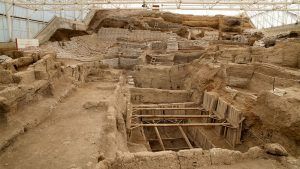Michael Price in Science:
 A bit more than 8000 years ago, the world suddenly cooled, leading to much drier summers for much of the Northern Hemisphere. The impact on early farmers must have been extreme, yet archaeologists know little about how they endured. Now, the remains of animal fat on broken pottery from one of the world’s oldest and most unusual protocities—known as Çatalhöyük—is finally giving scientists a window into these ancient peoples’ close call with catastrophe. “I think the authors have done an excellent job,” says John Marston, an environmental archaeologist at Boston University who wasn’t involved in the current study. “It shows the people of Çatalhöyük were incredibly resilient.” Today, Çatalhöyük is just a series of dusty, sun-baked ruins in central Turkey. But thousands of years ago it was a bustling prehistoric metropolis. From about 7500 B.C.E to 5700 B.C.E., early farmers grew wheat, barley, and peas, and raised sheep, goats, and cattle. At its height, some 10,000 people lived there. Among its more noteworthy features, Çatalhöyük’s inhabitants were obsessed with plaster, lining their walls with it, using it as a canvas for artwork, and even coating the skulls of their dead to recreate the lifelike countenances of their loved ones.
A bit more than 8000 years ago, the world suddenly cooled, leading to much drier summers for much of the Northern Hemisphere. The impact on early farmers must have been extreme, yet archaeologists know little about how they endured. Now, the remains of animal fat on broken pottery from one of the world’s oldest and most unusual protocities—known as Çatalhöyük—is finally giving scientists a window into these ancient peoples’ close call with catastrophe. “I think the authors have done an excellent job,” says John Marston, an environmental archaeologist at Boston University who wasn’t involved in the current study. “It shows the people of Çatalhöyük were incredibly resilient.” Today, Çatalhöyük is just a series of dusty, sun-baked ruins in central Turkey. But thousands of years ago it was a bustling prehistoric metropolis. From about 7500 B.C.E to 5700 B.C.E., early farmers grew wheat, barley, and peas, and raised sheep, goats, and cattle. At its height, some 10,000 people lived there. Among its more noteworthy features, Çatalhöyük’s inhabitants were obsessed with plaster, lining their walls with it, using it as a canvas for artwork, and even coating the skulls of their dead to recreate the lifelike countenances of their loved ones.
Around 6200 B.C.E., climates cooled across the globe. Massive glacial lakes in North America emptied into the Atlantic Ocean, scientists believe, altering sea currents and weather patterns and triggering what’s known simply as the 8.2-kiloyear event (referring to its occurrence 8200 years ago). A team of researchers led by biochemists Mélanie Roffet-Salque and Richard Evershed of the University of Bristol in the United Kingdom and archaeologist Arkadiusz Marciniak at Adam Mickiewicz University in Poznań, Poland, wondered whether Çatalhöyük’s farmers left behind any trace of the climate shift. Over the past few years, Marciniak had been digging up fragments of clay pottery (or potsherds) left buried in ancient trash piles, dating from about 8300 to 7900 years ago.
More here.
